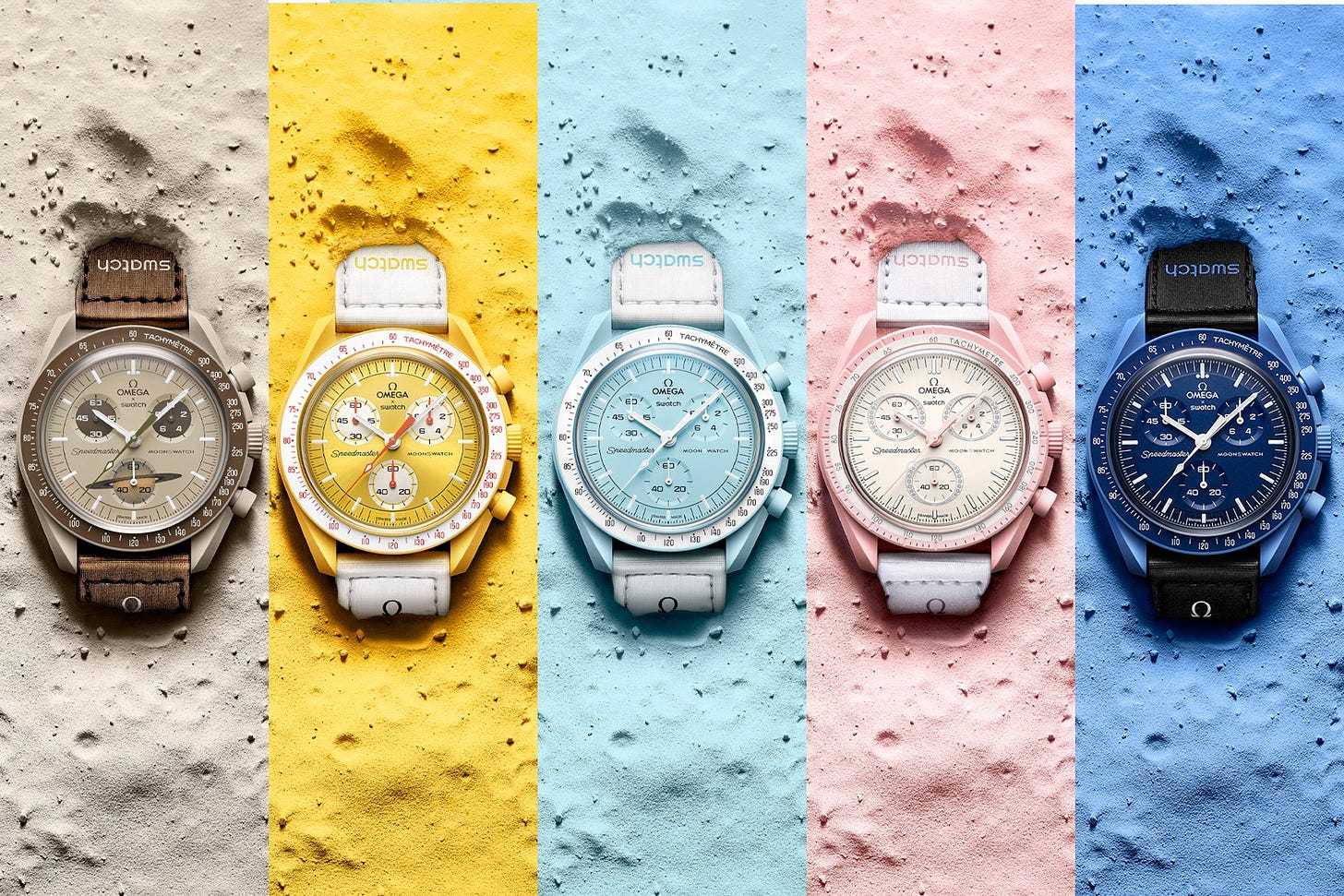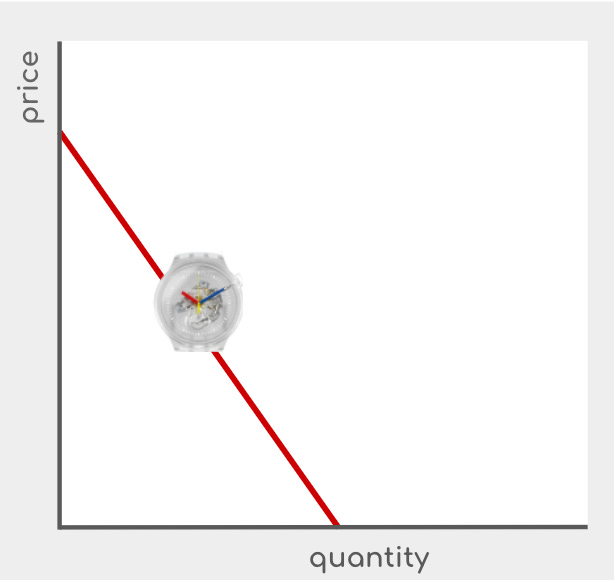Many of us working in advertising love to talk about generating demand and how we persuade people how to take the actions we want them to take. Buy more, be curious, have FOMO, join the movement, social proof. But the classic economic model of supply and demand isn’t something we spend much time on. So let’s get into the dismal science a bit, shall we?
Our role as marketers is to increase demand. This increases the quantity demanded, and increases the price people are willing to pay. When more people want our product, ideally it’s priced correctly so that they can buy the product.
Now let’s break it down with the latest hot commodity: the SwatchxOmega.
I remember getting a Swatch watch as a kid. It was the coolest thing: a grey band, a clear dial, pink, yellow and turquoise cogs. I loved the hell out of it. And then I didn’t think about Swatch again until about a week ago, when they dropped their partnership with Omega for space watches.
Omega, on the other hand, is my husband’s favorite watch brand. He can wax on for hours about the minutiae of the gears, the story of how his watch went to space in the 1960s, why the fabric band is cooler than the metal bracelet.
And voila, these two brands partnered along with a material no one’s heard of, bioceramics. They released 11 types of watches, one for each planet, plus the sun and the moon, for $260 a piece.
In economics, you illustrate what you expect people will pay (price) and how much you expect people to buy (quantity) on the demand curve, showing how as a product gets pricier, fewer people will pony up to pay for it, in a chart like this:
The Swatch x Omega watches sold out globally in hours. There are lines around the block in cities around the world. Swatch had to close some of its shops due to crowds, and police were even deployed at one location. The resale value spiked up to $7,890 eBay. Swatch apologized, having not expected their little partnership to enter a hype cycle wilder than Coachella tickets or Supreme collabs.
This hype pushed the demand curve far to the right. In order to meet the demand, Swatch would have to flood the market. Or, as is happening on the resale market, raise the price.
But why though?
Why is a watch worth $260 in the shop worth so much more the second it hits the open market? A typical shopper in the market for a $250-some dollar watch may not be in it with the same collector’s zeal of a watch-head who’s splashing out on a Patek Philippe. He might instead be looking at competitors like Shinola, and weighing out price versus style versus functionality. But what Swatch tapped into is a different mindset. The power of collabs, limited editions, capsule collections, and other one-offs makes it so there is no substitution for that product to the discerning buyer. What the consumer is buying is not just a product, but a claim on a story. On having something that it’s hard for others to get. On the envy of their friends and followers. The social value of the product far outstrips its actual value.
Swatch was one of the first companies to realize the power of social value by consistently changing designs. In the 1980s and 90s, Swatch completely changed the role of watches:
It created a new phenomenon: ‘watch wardrobing,’ i.e., buying multiple watches for different outfits or occasions.
Swatch turned watches from being timekeepers and symbols of wealth and power into being a collector’s item. And not a collector’s item like a vintage car, but a collector’s item like a Garbage Pail Kid. Amassing Swatches wasn’t about signifying class status like a Rolex was. It was about being in the know and having access, abundance, and cool.
It started the Swatch Art Special, collaborating with contemporary artists in a way that set the stage for partnership between art and commerce that lasted until today. Keith Haring partnered with Swatch in 1986 when he was alive and in his heyday, before his work posthumously got licensed to every brand under the sun. Hodinkee, the watch specialist site, talks about how Swatch drove demand by adding art, design and lifestyle.
From the very start, the program would establish a legacy of creating not only special Swatches but also uniquely collectible objects that blurred the lines between watches, art, and even apparel.
Swatch isn’t new to the resale spike caused by its partnerships either. In 1992, a Keith Haring Swatch, which retailed for $50 a few years earlier, was worth $5,500 on the collector’s market.
Swatch’s playbook is now everywhere. The proliferation of high-low collabs, from H&M’s capsule collections to Gucci x NorthFace to Gap x Kanye x Balenciaga, shows the power of multiplying the mass access and the desirability of luxury to spike demand.
You’ve just read Framing, a monthly newsletter about culture, marketing, and business by Anita Schillhorn van Veen. I’m currently Director of Strategy at McKinney, on the lead team of Ladies Who Strategize, and a writer over at my other favorite Substack Why Is This Interesting.
I put this out for free because I enjoy writing and thinking through problems—if you enjoyed this, you can support my work by buying me a coffee.







My key takeaways from this. Space sells, I need to buy a watch, and love this salient point about a consumer mindset shifts when a brand fashions the right pairing of brands..."other one-offs makes it so there is no substitution for that product to the discerning buyer". Interesting way to frame your way out of a competitive set, collab your way into a one of a kind.